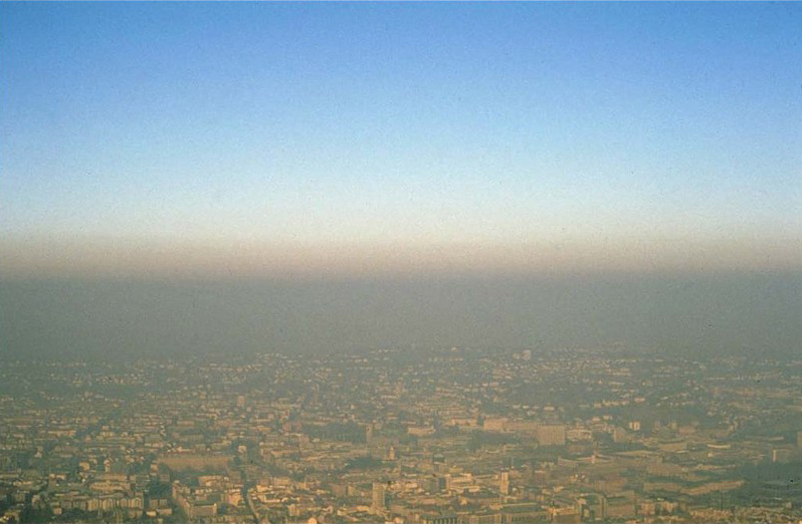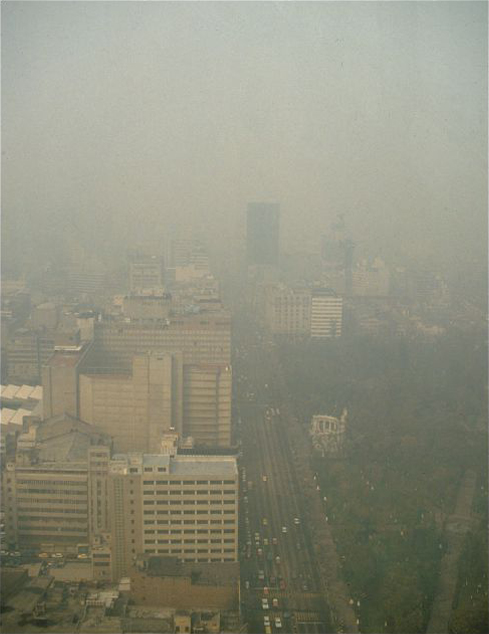|
|
| CHARACTERISTICS AND FORMS OF THE URBAN CLIMATE |  |
| | | |
 2.9 Pollutant Levels and Threshold Values 2.9 Pollutant Levels and Threshold Values |
The wide array of substances in the urban atmosphere – some studies of the air in cities have identified more than 1,000 different substances – does not allow all components to be regularly monitored. The resulting vapor bell above the city – characterized in its extreme form as smog – does not only afflict humans, it also reduces the general brightness, the amount of solar radiation received, and the duration of sunshine.
Inversion weather conditions strongly enrich the urban air with pollutants. Figure 2/23 shows a inversion situation in Stuttgart. The higher the altitude of this lower inversion boundary is, the greater is the volume of the mixed air above the city. In addition, the concentrations of various pollutants depend upon the altitude of the typical source. At low inversion lower limit is primarily affected by traffic emissions from ( low dropout height ). A rising inversion lower limit rise to industrial units , since now higher sources entering the mixing layer.
Since the middle of the 1960s pollutants in Baden-Württemberg have been analyzed regularly. Although reductions in the levels of sulfur dioxide and particulate matter are recognizable, levels of the pollutant nitrogen dioxide (NO2) have increased further. This is due primarily to continuously increasing traffic. In cities above all, the threshold values of the TA Luft publication (1986) are in part exceeded in street canyons (LANDESHAUPTSTADT STUTTGART, 2012; REGIERUNGSPRÄSIDIUM STUTTGART, 2005 und 2010).
Classical smog situations no longer exist nowadays. The term "smog" is a combination of "smoke" and "fog"; it is used to describe heavy, partially visible air pollution above urban and industrial agglomerations. Today the term is used more generally describing a high level of airborne pollution even without the visible fog.
The problem of high pollutant concentrations in cities is not new. Even in 66 AD, Seneca wrote: "As soon as I escaped from the oppressive atmosphere of Rome , and from that awful odour of reeking kitchens which, when in use, pour forth a ruinous mess of steam and soot, I perceived at once that my health was mended."
It is long known that there is a connection between air pollution and health problems. This becomes most apparent when the rate of fatalities is higher than average in times of heavy smog, like during the smog catastrophe of London in 1952 when more than 4,000 people died.
Besides a high pollutant concentration during inversions in winter, which are the result of exhaust gases from heating and traffic, there is also smog in summer (Fig. 2/23a).The major source of summer smog is traffic (with e.g. nitrogen oxides, hydrocarbons and carbon monoxide). Due to bad air exchange conditions in combination with strong insolation, the gases are chemically converted in the atmosphere and photo-oxidants are produced. In this context, the main substances are ozone (O3) and peroxyacetyl nitrate (PAN) along with peroxides, aldehydes etc.
|
|
| | | |
 |
| Fig. 2/23: Obstructed air exchange with concentrated pollutants during a low-altitude inversion | | |
 |
| Fig. 2/23a: Smog in Mexico-City, type summer smog "LOS ANGELES" |
|
